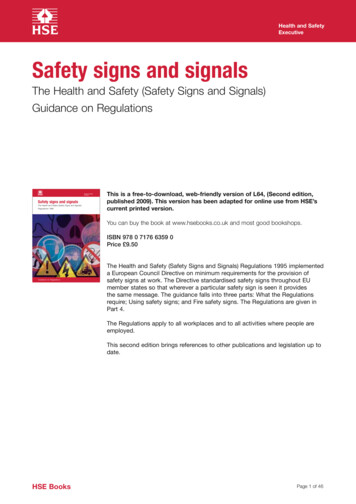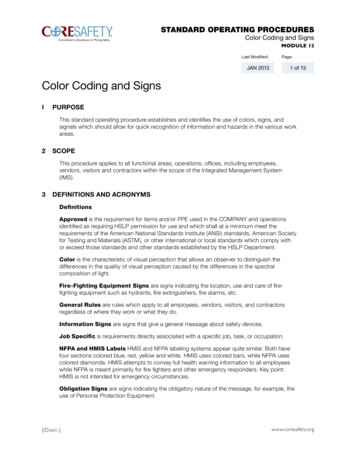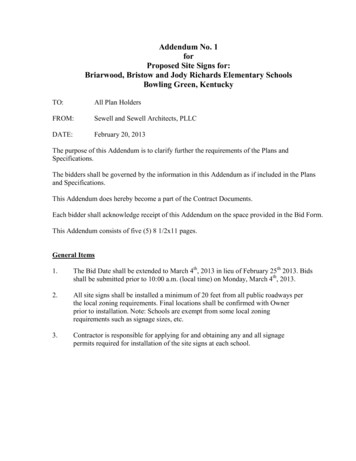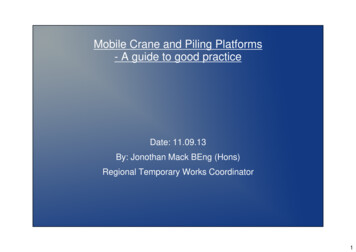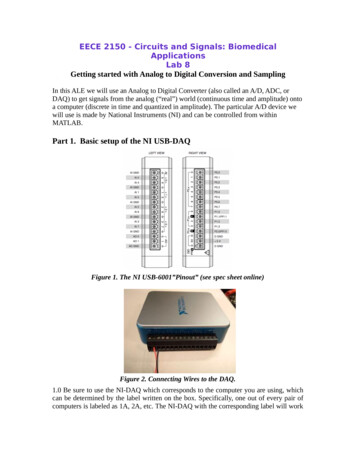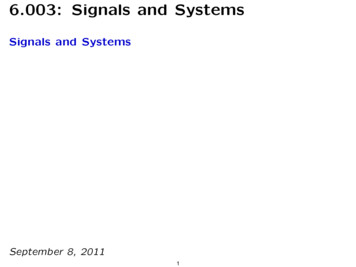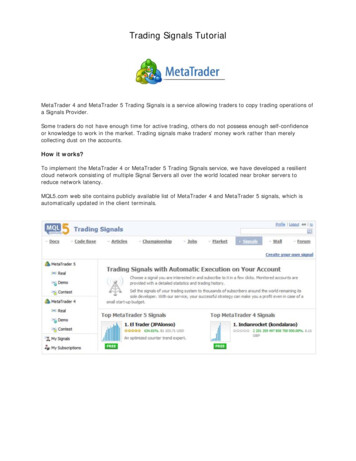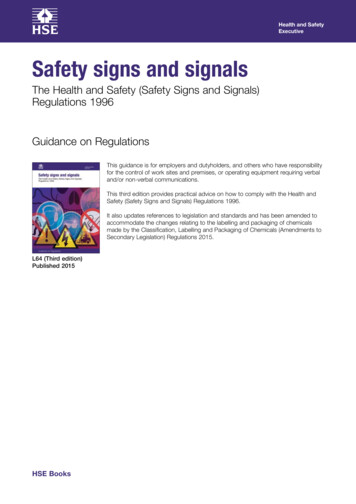
Transcription
Health and SafetyExecutiveSafety signs and signalsThe Health and Safety (Safety Signs and Signals)Regulations 1996Guidance on RegulationsThis guidance is for employers and dutyholders, and others who have responsibilityfor the control of work sites and premises, or operating equipment requiring verbaland/or non-verbal communications.This third edition provides practical advice on how to comply with the Health andSafety (Safety Signs and Signals) Regulations 1996.It also updates references to legislation and standards and has been amended toaccommodate the changes relating to the labelling and packaging of chemicalsmade by the Classification, Labelling and Packaging of Chemicals (Amendments toSecondary Legislation) Regulations 2015.L64 (Third edition)Published 2015HSE Books
Health and SafetyExecutiveSafety signs and signals Crown copyright 2015First published 1996Second edition 2009Third edition 2015ISBN 978 0 7176 6598 3You may reuse this information (excluding logos) free of charge in any format ormedium, under the terms of the Open Government Licence. To view the licencevisit cence/, write to theInformation Policy Team, The National Archives, Kew, London TW9 4DU, oremail psi@nationalarchives.gsi.gov.uk.Some images and illustrations may not be owned by the Crown so cannot bereproduced without permission of the copyright owner. Enquiries should be sent tocopyright@hse.gsi.gov.uk.GuidanceThis guidance is issued by the Health and Safety Executive. Following the guidanceis not compulsory and you are free to take other action. But if you do follow theguidance you will normally be doing enough to comply with the law. Health andsafety inspectors seek to secure compliance with the law and may refer to thisguidance.Page 2 of 49
Health and SafetyExecutiveSafety signs and signalsContentsIntroduction5PART 1 About the Regulations7What do the Regulations require?What about information, instruction and training?What is a safety sign?Where and to whom do these Regulations apply?Circumstances where these Regulations do not applyPART 2 Using safety signs77891011Using safety signs effectively11Using signboardsSignboards appearing in Schedule 1Using signs on containers and pipesUsing signs to mark areas, rooms and enclosures12132021Using signs to mark obstacles, dangerous locations andtraffic routes21Using acoustic signals and illuminated signsUsing hand signals to direct hazardous operationsUsing verbal signals to direct hazardous operationsPART 3 Fire safety signs26What is a fire safety sign?Using signs in buildings and structuresMarking and identifying firefighting equipmentEnforcing authority for fire safetyFire alarmsInformation, instruction and training2627282829PART 4 The Health and Safety (Safety Signs and Signals)Regulations 199630References and further readingFurther information224649Page 3 of 49282425
Health and SafetyExecutiveSafety signs and signalsPage 4 of 49
Health and SafetyExecutiveSafety signs and signalsIntroductionAbout this book1This guidance provides practical advice on how to comply with the Health andSafety (Safety Signs and Signals) Regulations 1996 (the Regulations).Who should read this book?2This book is for employers and dutyholders and others who have responsibilityfor the control of work sites and premises, or operating equipment requiring verbaland/or non-verbal communications. Throughout this book we have referred to theemployer and others who have duties as ‘you’. Where the guidance is addressedto some other dutyholder, for example a competent person, the text makes it clearwho it is intended for.Changes in this edition3The majority of changes in this edition have been to update references tolegislation and Standards enacted or updated recently, eg the Regulatory Reform(Fire Safety) Order 2005 and Graphical symbols: Safety colours and safety signs.Registered safety signs – BS EN ISO 7010:12 A5:2015 (referred to asBS EN ISO 7010 in this book). Details of relevant Standards and legislation appearin Further reading.4The document has also been amended to accommodate the changesresulting from the Classification, Labelling and Packaging of Chemicals(Amendments to Secondary Legislation) Regulations 2015 (the CLP (Amendment)Regulations) relating to labelling and packaging of chemicals.5The signs appearing in Part 2 of this book are examples of appropriate signs.Some examples have been included from BS EN ISO 7010 to demonstrate thetypes of variations permitted. There will be others available as the Regulationspermit variations and additional signs as long as they retain the intrinsic featuresdescribed. Please note the change in the warning signs – the deletion of the‘Harmful or irritant material’ warning sign – as a result of the CLP (Amendment)Regulations.About the Regulations6The Regulations implement European Council Directive 92/58/EEC onminimum requirements for the provision of safety signs at work. They requireemployers to provide safety signs where other methods, properly considered,cannot deal satisfactorily with certain risks and where the use of a sign can furtherreduce that risk.Page 5 of 49
Health and SafetyExecutiveSafety signs and signals7They cover traditional safety signs such as ‘No entry’ signs, and other meansof communicating health and safety information such as hand signals, acousticsignals (eg warning sirens on machines) and verbal communications such as prerecorded evacuation messages.8The Directive standardises safety signs throughout member states of theEuropean Union (EU) so that wherever a particular safety sign is seen it providesthe same message. The intention is that workers moving from site to site, such asservice engineers, will not be faced with different signs at different workplaces.9The CLP (Amendment) Regulations, which came into force on 1 June 2015,made some amendments to these Regulations. These are reflected in this guidanceand the Regulations in Part 4 have been revised to show the amended version.10 Regulation (EC) No 1272/2008 (the CLP Regulation) on classification, labellingand packaging of substances and mixtures, adopts the United Nations’ GloballyHarmonised System on the classification and labelling of chemicals (GHS) across allEU countries, including the UK. As GHS is a voluntary agreement rather than a law,it has to be adopted through a suitable national or regional legal mechanism toensure it becomes legally binding. That is what the CLP Regulation does. As GHSwas heavily influenced by the old EU system, the CLP Regulation is very similar inmany ways. The duties on suppliers are broadly the same: classification, labellingand packaging.11 The CLP Regulation replaced the previous European legislation onclassification, labelling and packaging of dangerous substances and preparations.As a result, a number of European Directives were amended to reflect the changeto the law. Domestic legislation then also had to be amended, to implement thechanges at European level. The CLP (Amendment) Regulations made thosechanges to domestic legislation, including to the Regulations.About this guidance12This publication consists of:(a)guidance (Parts 1–3):(i)Part 1 ‘About the Regulations’ covers safety signs in general;(ii) Part 2 ‘Using safety signs’ contains advice on their selection, andexplains the general requirements for the proper use of safety signs,including technical requirements (eg shape, colour etc) for different typesof sign. The signs are also reproduced in full colour in Part 2;(iii) Part 3 ‘Fire safety signs’ covers similar details for fire safety signs;(b)the Regulations (Part 4).Consulting employees13 If you are an employer you have a legal duty to consult with your employeeson matters relating to health and safety in the workplace. For further informationsee Consulting employees on health and safety: A brief guide to the law.1Page 6 of 49
Health and SafetyExecutiveSafety signs and signalsPART 1 About the RegulationsGuidanceWhat do the Regulations require?14 The Regulations require employers to ensure that safety signs are provided (orare in place) and maintained in circumstances where there is a significant risk tohealth and safety that has not been removed or controlled by other methods. Thisis only appropriate where use of a sign can further reduce the risk. The othermethods may include engineering controls or safe systems of work and may berequired under other relevant legislation. Safety signs are not a substitute for thoseother methods of control.15 In determining when and where to use safety signs, employers must take intoaccount the results of the risk assessment made under the Management of Healthand Safety at Work Regulations 1999 (the Management Regulations).2 Thisassessment should identify hazards, the risks associated with those hazards, andthe control measures to be taken. When those control measures have been put inplace there may be a significant ‘residual’ risk such that employees must bewarned of any further measures necessary. Safety signs should be used if they willhelp to further reduce this residual risk. If the risk is not significant there may be noneed to provide a sign.16 These Regulations make it clear that safety signs are not a substitute for othermeans of controlling risks to employees; safety signs are to warn of any remainingsignificant risk or to instruct employees of the measures they should take in relationto these risks. For example, in some workplaces there may be a risk of foot injurydespite taking measures to control the risk and it may be appropriate to remindstaff using the sign indicating that wearing foot protection is mandatory.17 Although these Regulations do not require safety signs to be used where thereis no significant risk to health and safety, certain fire safety signs may have to bedisplayed under separate legal provisions. If you have any doubts check this withyour enforcing authority for fire safety.What about information, instruction and training?18 It is important that employers ensure that their employees are aware of andunderstand the meaning of safety signs and signals either seen or heard duringtheir work, including providing training where necessary. Although most safety signsare self-explanatory, employees (particularly new, young or inexperienced ones)may be unfamiliar with the meaning of some of the less commonly used signs. It istherefore important that the meaning of any sign is clearly explained, and thatemployees are aware of the consequences of not following the warning orinstruction given by the sign. Text supplementing the sign may have a usefulrole here.Page 7 of 49
Health and SafetyExecutiveGuidanceSafety signs and signalsWhat is a safety sign?19 The Regulations cover a variety of methods of communicating health andsafety information. The terms used in the Regulations mean the following:(a)(b)(c)(d)(e)(f)(g)safety and/or health sign – a sign providing information or instruction aboutsafety or health at work by means of a signboard, a colour, an illuminated signor acoustic signal, a verbal communication or hand signal;signboard – a sign which provides information or instructions by acombination of shape, colour and a symbol or pictogram which is renderedvisible by lighting of sufficient intensity. In practice, many signboards may beaccompanied by supplementary text, eg ‘Fire exit’, alongside the symbol of amoving person. Signboards can be of the following types:(i)prohibition sign – a signprohibiting behaviour likely toincrease or cause danger (eg ‘noaccess for unauthorised persons’);(ii)warning sign – a sign givingwarning of a hazard or danger(eg ‘danger: electricity’);(iii)mandatory sign – a signprescribing specific behaviour(eg ‘eye protection must be worn’);(iv)emergency escape or first-aidsign – a sign giving information onemergency exits, first aid, orrescue facilities (eg ‘emergencyexit/escape route’;safety colour – a colour to which a specific meaning is assigned (eg yellowmeans ‘be careful’ or ‘take precautions’);symbol or pictogram – these appear in Schedule 1, although somevariation in detail is acceptable provided the meaning is the same (examplesof variations are included in BS EN ISO 7010). They are for use on asignboard or illuminated sign (eg the trefoil ionising radiation warning sign);illuminated sign – a sign made of transparent or translucent materialswhich is illuminated from the inside or the rear to give the appearance of aluminous surface (eg emergency exit signs);acoustic signal – a sound signal which is transmitted without the use of ahuman or artificial voice (eg a fire alarm);verbal communication – a predetermined spoken message communicatedby a human or artificial voice;Page 8 of 49
Health and SafetyExecutiveGuidanceSafety signs and signals(h)(i)hand signal – a movement or position of the arms or hands giving arecognised signal and guiding people who are carrying out manoeuvres whichare a hazard or danger to people;fire safety sign – see Part 3.Where and to whom do these Regulations apply?Employers/employees20 The Regulations place duties on employers in respect of risks to theiremployees with the principal duty being to ensure that safety signs are in place.21 In some industries, for example offshore, many employees are employed bycontractors who are not in control of the places in which their employees work. Inpractice, safety signs will normally be provided by the employer or person in chargeof the workplace, usually the owner or operator of the installation. The ManagementRegulations are relevant in these cases, particularly regulation 12. This requires the‘host’ employer (or self-employed person) to give information on risks and theassociated precautions arising from that employer’s activities to the employer ofpersons at work there. In these cases, the employer or contractor will usually beable to meet their obligations by relying on the arrangements made by the host(ie the owner o
Graphical symbols: Safety colours and safety signs. Registered safety signs – BS EN ISO 7010:12 A5:2015 (referred to as BS EN ISO 7010 in this book). Details of File Size: 2MBPage Count: 49
